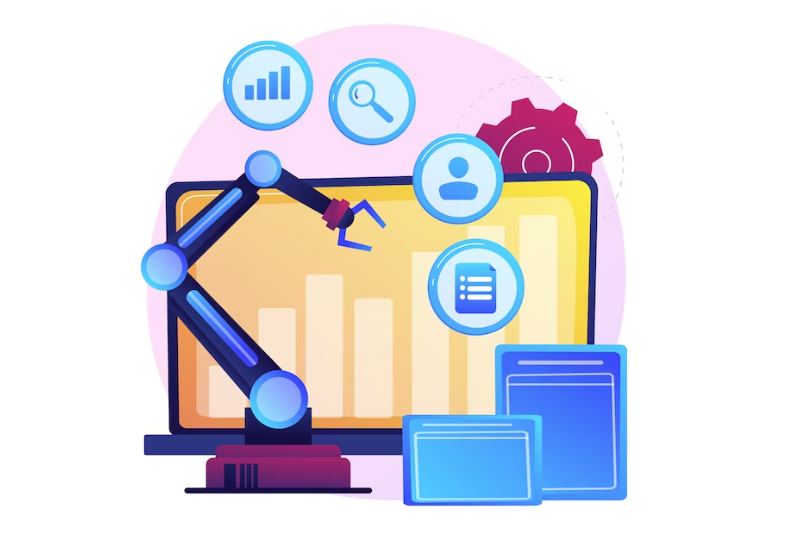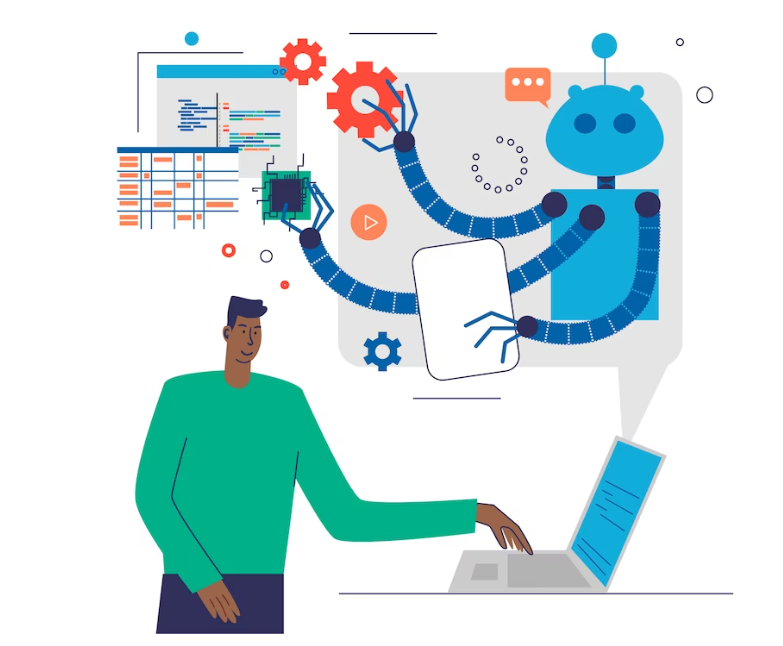Streamline Your Processes with Digital Automation
What is Digital Automation?
Digital automation is the use of technology to perform repetitive and time-consuming tasks, which are traditionally done manually by humans. It involves the use of software tools, algorithms, and other technologies to automate business processes and increase efficiency. Digital automation can be applied to a wide range of tasks, from data entry and document processing to customer service and supply chain management.
One of the key benefits of digital automation is that it allows businesses to streamline their processes and free up valuable time and resources. By automating routine tasks, employees can focus on higher-value activities that require human expertise, such as decision-making, problem-solving, and creative thinking.
Digital automation also enables businesses to improve accuracy and reduce errors. Unlike humans, automation tools are not prone to fatigue, distraction, or human error, which can result in costly mistakes. By minimizing errors, businesses can enhance their quality and consistency, leading to greater customer satisfaction and loyalty.

Benefits of Digital Automation
Digital automation offers numerous benefits to businesses of all sizes, including:
Increased efficiency: Automation can help businesses complete tasks faster and more efficiently than traditional manual methods. This can lead to increased productivity, reduced costs, and a faster time to market.
Improved accuracy: Automation tools are not prone to the errors and mistakes that humans can make, which can help improve accuracy and reduce the risk of costly errors and rework.
Better quality: Automation can help ensure that processes are completed consistently and according to predefined rules and standards, which can help improve the overall quality of products and services.
Cost savings: By automating repetitive and time-consuming tasks, businesses can reduce labor costs and increase profitability.
Enhanced scalability: Automation can help businesses scale their operations more quickly and easily than manual methods. As demand grows, businesses can add more automation tools and workflows to keep pace with increased volume.
Improved customer experience: By streamlining processes and reducing errors, businesses can enhance the customer experience and build greater customer loyalty.
Access to data insights: Automation can help businesses collect and analyze data more efficiently and accurately, which can provide valuable insights for decision-making and strategic planning.
Unlocking Business Potential with AI, GPT-3, ChatGPT and Chatbot Development
Key Features of Digital Automation
Digital automation offers a range of features that can help businesses streamline their processes and increase efficiency. Some of the key features of digital automation include:
Workflow automation: This involves automating repetitive and manual tasks, such as data entry, document processing, and customer service, using software tools and algorithms.
Artificial intelligence (AI) and machine learning (ML): These technologies can help automate more complex tasks, such as natural language processing and image recognition, by learning from data and improving over time.
Robotic process automation (RPA): This involves using software robots to automate repetitive and rules-based tasks, such as data entry and invoice processing, without the need for human intervention.
Integration with other systems: Digital automation tools can be integrated with other systems, such as customer relationship management (CRM) and enterprise resource planning (ERP), to streamline processes and reduce manual intervention.
Real-time monitoring and reporting: Automation tools can provide real-time monitoring and reporting of processes, allowing businesses to identify and address issues quickly and efficiently.
Customization and flexibility: Digital automation tools can be customized to meet the specific needs of businesses and adapted to changing requirements and workflows.
Security and compliance: Digital automation tools can help businesses comply with regulatory requirements and ensure data security and privacy.
Assessing Your Business Processes for Automation
Before implementing digital automation in your business, it’s important to assess your current processes to identify which tasks are best suited for automation. Here are some steps you can follow to assess your business processes for automation:
Identify repetitive and time-consuming tasks: Start by identifying tasks that are done repeatedly and take up a significant amount of time. These are the tasks that are most likely to benefit from automation.
Determine the business impact of automating each task: Consider the potential benefits of automating each task, such as increased efficiency, improved accuracy, and cost savings. Also, consider the potential risks and challenges of automating each task, such as data security and privacy concerns.
Analyze your data and workflows: Review your data and workflows to identify areas where automation can help improve efficiency and accuracy. Look for patterns and trends that can be used to automate processes and tasks.
Consider the feasibility of automation: Assess the feasibility of automating each task based on the availability of automation tools and technologies, the cost of implementation, and the potential return on investment.
Prioritize tasks for automation: Based on your analysis, prioritize tasks for automation based on their potential impact on the business and the feasibility of implementation.
Best Practices for Implementing Digital Automation
Implementing digital automation can be a complex process that requires careful planning and execution. Here are some best practices to keep in mind when implementing digital automation in your business:
Start with a clear goal: Define a clear and specific goal for your automation project, such as reducing costs, improving quality, or increasing efficiency. This will help you stay focused on the outcomes you want to achieve and avoid scope creep.
Involve stakeholders: Involve all relevant stakeholders in the automation process, including employees, managers, and customers. This will help ensure that everyone is aligned and committed to the project and that the automation meets their needs.
Choose the right technology: Choose the technology that best meets your needs and requirements, based on factors such as cost, scalability, flexibility, and ease of use. Consider using open-source technologies, as they can provide greater flexibility and customization.
Start small and scale up: Start with a pilot project or a small-scale implementation to test the technology and identify any issues or challenges. Once you have successfully implemented the automation, scale it up gradually to other areas of the business.
Train and support employees: Provide adequate training and support to employees who will be using the automation tools. This will help ensure that they understand how to use the tools effectively and can maximize their benefits.
Monitor and measure progress: Monitor and measure the progress of your automation project regularly to ensure that it is meeting its goals and objectives. Use metrics such as efficiency gains, cost savings, and customer satisfaction to evaluate the success of the project.
Continuously improve: Continuously improve your automation processes by identifying opportunities for optimization and refinement. Use feedback from stakeholders and data insights to refine your automation workflows and improve their performance.
Tools and Technologies for Digital Automation
Digital automation involves a variety of tools and technologies that can help businesses automate their processes. Here are some of the most common tools and technologies used for digital automation:
Robotic Process Automation (RPA): RPA is a software technology that uses robots to automate repetitive, rules-based tasks. RPA robots mimic human actions and can work 24/7, reducing the need for manual intervention.
Artificial Intelligence (AI) and Machine Learning (ML): AI and ML technologies can be used to automate more complex tasks that require cognitive skills, such as natural language processing and image recognition. AI and ML can learn from data and improve over time, allowing for greater accuracy and efficiency.
Business Process Management (BPM) software: BPM software helps businesses automate and manage their workflows by providing tools for modeling, analyzing, and optimizing processes.
Low-code and no-code platforms: Low-code and no-code platforms allow users to build custom applications and workflows without the need for coding. These platforms can help businesses quickly build and deploy automation solutions.
Chatbots and virtual assistants: Chatbots and virtual assistants can be used to automate customer service and support tasks, such as answering common questions and providing product recommendations.
Optical Character Recognition (OCR) software: OCR software can be used to automate the processing of paper-based documents, such as invoices and receipts, by converting them into digital formats that can be processed by other automation tools.
Enterprise Resource Planning (ERP) software: ERP software can help businesses automate and streamline their financial and accounting processes, such as accounts payable and accounts receivable.

Conclusion
In conclusion, digital automation has become a critical component of modern business operations, offering significant benefits to businesses of all sizes and industries. By leveraging automation technologies such as RPA, AI, ML, and IoT, businesses can achieve greater efficiency, accuracy, and quality in their operations while reducing costs and improving customer satisfaction.
Assessing business processes for automation, implementing best practices, and leveraging the latest tools and technologies are essential for successful automation implementation. It’s also important for businesses to stay up-to-date with emerging trends and technologies in digital automation to remain competitive and deliver greater value to their customers.
As digital automation continues to evolve, businesses that embrace automation and continuously innovate and optimize their automation solutions will be best positioned for success in the years ahead.
If you’re interested in learning more about how digital automation can benefit your business and streamline your operations, we encourage you to contact us today. Our team of experts can provide guidance and support in assessing your business processes for automation, developing a digital automation strategy, and implementing the latest automation technologies and tools.
